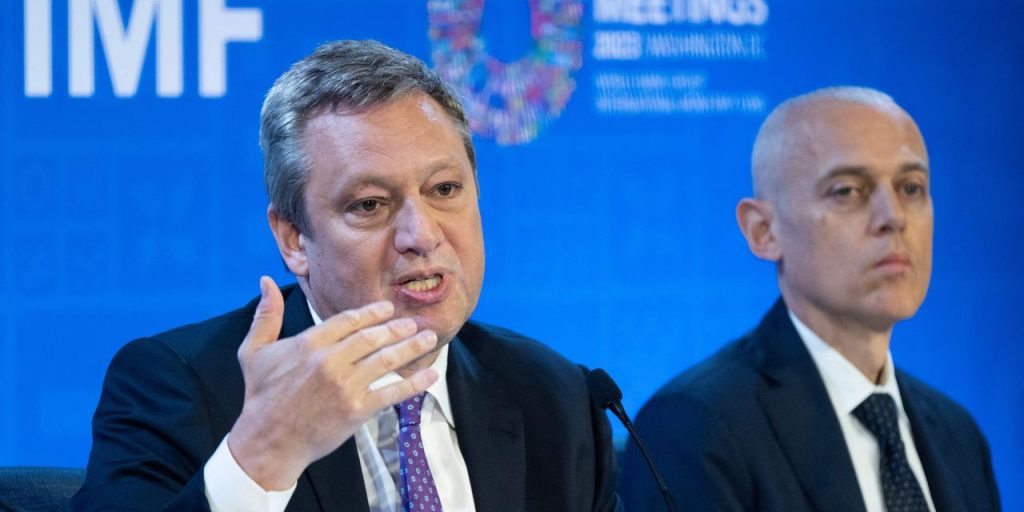Risks to financial stability have risen “significantly” amid the recent turmoil in the banking sector, the International Monetary Fund’s economists said on Tuesday, sounding a warning about hidden trouble, not just at banks but also nonbank financial intermediaries.
For several years, the multilateral organization has warned in its Global Financial Stability report of the potential fallout of interest rate rises after an era of historically low rates on banks and nonbank financial intermediaries. Those have come to pass with the trouble at
Credit Suisse
(ticker: CS) and failures of Silicon Valley Bank and Signature Bank in the U.S.
There could be more pockets of strain but the steps policy makers have taken in recent weeks have contained the situation for now, Tobias Adrian, director of the IMF’s Monetary and Capital Markets Department, said in a press briefing as the IMF and World Bank kicked off their annual spring meetings in Washington. He expects monetary policy to stay focused on inflation, which has proven to be more persistent than expected.
While some economists have been critical about the Federal Reserve’s rate path in the wake of the banking turmoil, Adrian described the pace of tightening as appropriate. Though the banking turmoil and the tightening monetary policy has led to some contraction in lending, Tobias doesn’t see that as a financial stability issue—at least not yet.
While IMF economists described the failed Silicon Valley Bank as an outlier in terms of the degree of unrealized losses and wholesale deposits that made it more vulnerable, other trouble spots could emerge from the dangerous combination of tighter financial conditions, mismatches in asset and liability liquidity and financial leverage, as well as the links between the nonfinancial banking sector and traditional banks.
For example, the IMF noted that life insurers have doubled illiquid investments over the last decade to boost returns and increasingly use leverage to fund illiquid assets. Other pressure points include venture capital in technology and commercial real estate, according to IMF economists. In the U.S., banks with less than $250 billion in assets account for three-quarters of commercial real estate bank lending, making these smaller banks vulnerable if there’s a deterioration in asset quality in the sector.
Trouble in the commercial real estate sector could ripple through to nonbank financial players that invest heavily in the real estate investment trust and commercial mortgage-backed securities markets, the IMF economists caution.
Emerging markets are often a vulnerable part of the market in times of financial strains, but the group on the whole is in relatively decent position. Central bankers in many emerging markets raised rates ahead of their peers in U.S. and Europe, and last year’s currency weakness has eased. Emerging market banks are also much less exposed to duration risk of rising rates, helped in part with a stickier deposit base than the likes of Silicon Valley Bank’s wholesale deposits, according to the IMF economists.
But pockets of concern still loom, with about 60% of low income countries and 25% of emerging economies in or at high risk of debt distress and facing default like credit spreads, IMF Chief Economist Pierre-Olivier Gourinchas said in a separate briefing.
One area to watch closely:
Frontier
markets where local banks have loaded up on local sovereign debt, raising the risks of a crisis, especially as some cash-strapped countries struggle to access international sovereign debt markets. Pakistan, for example, has seen its foreign reserves shrink as it contends with soaring food and fuel prices and is seeking an IMF bailout.
The IMF economists urged policy makers to address gaps in surveillance, supervision, and regulation, adding that they “must act resolutely to maintain trust.” And in the debate over rescue efforts to contain the recent crisis, the IMF said more work is needed on dealing with future turmoil to increase the likelihood that systemic banks can be resolved without putting public funds at risk.
And like others critical of the messaging from the Fed recently, IMF economists advised central bankers to clearly communicate any adjustments to their monetary policy to ward off financial instability, and then return to their inflation fight as soon as financial stresses ease.
For now, based on the IMF’s measure of risks to global economic growth from financial instability, the organization sees a 1-in-20 chance global GDP shrinks by 2.8% in a severe tightening of financial conditions in which corporate and sovereign spreads widen, stock prices fall, and currencies weaken in most emerging economies.
But ripples from financial instability tend to unfold gradually, with the demise of Bear Stearns in March 2008, followed by months of relative calm, Nathan Sheets,
Citi
‘s chief economist, wrote in a note to clients. Sheets puts a roughly one-third chance of a more damaging outcome for the global economy from a tightening in bank lending conditions and some form of credit crunch.
The message: Don’t get sanguine just yet and keep an eye on potential trouble spots.
Write to Reshma Kapadia at reshma.kapadia@barrons.com
Read the full article here



